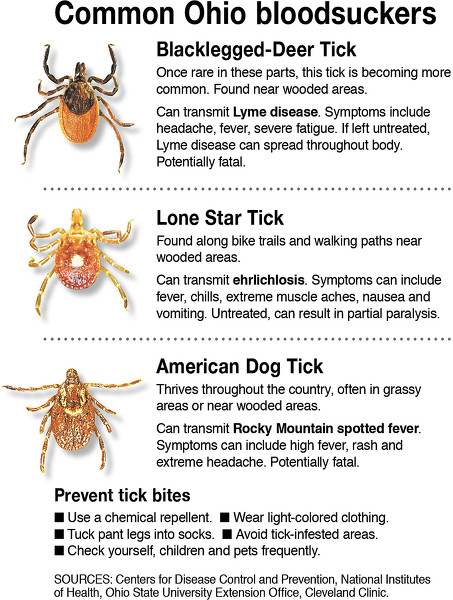Wednesday, June 1st, 2022
Ticks Attack
The bugs are back and out for blood
By Leslie Gartrell
Temperatures are rising and so is Ohio's tick population, according to national and state officials.
Diseases spread by ticks are an increasing concern in the state, with reports flowing into the Ohio Department of Health more frequently over the past decade - including that of an allergy to red meat caused by the bite of a Lone Star ticks.
In fact, the Centers for Disease Control and Prevention estimates that between 2004 and 2019, the total number of tick-borne diseases in the United States more than doubled.
Although ticks can be encountered during any season, spring marks the beginning of their onslaught. This year, the tick population statewide is expected to further swell due to global climate change and tick-host range expansion, according Tim McDermott, an educator with Ohio State University Extension.
"Ticks are extraordinarily adaptable and can travel on host animals," he said in an OSU College of Food, Agricultural and Environmental Sciences news release. "Ticks expand when their habitat range expands due to global climate change. They take advantage of what they can take advantage of to move to new spaces. So now, every year going forward has the potential to be bad, and you should go into each tick season thinking about how you can keep you and your family tick-safe."

Photo by Bill Thornbro/The Daily Standard
Common ticks found in the Grand Lake area.
For example, the American dog tick was the only tick in Ohio that was of medical importance to humans, companion animals and livestock 20 years ago, McDermott said in the release.
Now, there are five ticks in Ohio that concern experts. The American dog tick, the blacklegged tick - also known as the deer tick - and the Lone Star tick have become more prominent. Most recently, both the Asian longhorned tick and the Gulf Coast tick were confirmed in Ohio in 2020.
With the rising tick population comes the risk
of contracting tick-borne illnesses such as anaplasmosis, babesiosis, Rocky Mountain spotted fever and Lyme disease.
The Lone Star tick occasionally can trigger an allergic reaction to mammal meats such as pork, beef and lamb, according to the CDC. Symptoms can also appear after eating other food products with animal connections, such as dairy or gelatin.
Cases are rare, but growing, according to the Cleveland Clinic. Only 24 cases of the meat allergy, known as alpha-gal syndrome, were reported in the U.S. in 2009. By 2018, the number topped 34,000.
In addition to alpha-gal syndrome, the Lone Star tick is also a spreader of Lyme disease, Heartland virus, Bourbon virus and Southern tick-associated rash illness, according to the Cleveland Clinic.
ODH recommends watching for symptoms of tick-borne diseases. Symptoms often include fever, headache, joint pain, muscle aches, fatigue or a rash soon after a tick bite. Symptoms of Rocky Mountain spotted fever usually begin within five to 10 days after a bite. People should contact their health care provider if symptoms develop and tell them if they have had a tick bite or found a tick on themselves, according to ODH.
Auglaize County Health Department health commissioner Oliver Fisher in May said as tick season gets into full swing, it's important to check for ticks after spending time outdoors.
McDermott in the release said while the risk of encountering ticks in Ohio is high and the number of ticks that are carrying disease is high, people can take steps to protect themselves. One way to control ticks is through proper management of their habitat.
"Keep your yard mowed, and do not allow brush or leaf litter to accumulate," he said. "Remove brush, tall weeds, and grass in order to eliminate the habitat of rodents and other small mammals, which serve as hosts for ticks as well as serve as prime tick habitat."
Individuals should wear light-colored, long clothing, and tuck their pants legs into socks if applicable, according to ODH. Using EPA-registered repellents with DEET can protect against ticks.
Clothing and shoes correctly treated with the insecticide permethrin help deter ticks and can be purchased through many outfitters and clothing companies, according to the OSU extension release.
In addition to doing frequent tick checks once indoors, individuals should shower soon after being outside and thoroughly inspect themselves afterward, according to ODH.
Ticks often hitchhike on clothing, so people should examine their clothing in addition to equipment and pets. Dry clothes can be put into a dryer and tumble-dry on high heat for 10 minutes to kill ticks. If the clothes require washing first, hot water is recommended.
If a tick is found in the skin, people should begin removal by using fine-tipped tweezers to grasp the tick as close to the skin's surface as possible, pulling away from the skin with steady, even pressure, according to ODH.
People should not twist or jerk the tick as this can cause the mouth parts to break off and remain in the skin. If this happens, the mouth parts can be removed with tweezers. If an individual is unable to remove the mouth parts easily with clean tweezers, it should be left alone to let the skin heal.
Once the tick has been removed, people should wash their hands and the bite area with soap and water, according to ODH.
Live ticks can be disposed of by putting them in alcohol, placing them in a sealed bag or container, wrapping it tightly in tape or flushing it down the toilet, officials at ODH have said. People should never crush ticks with their fingers.
People should not use petroleum jelly, a hot match, nail polish or any other "folk" remedies to remove a tick, as these methods have never been proven to work, according to ODH.


